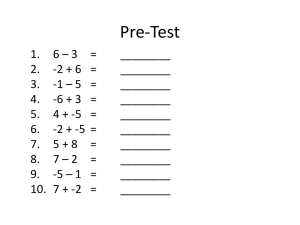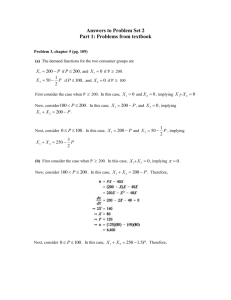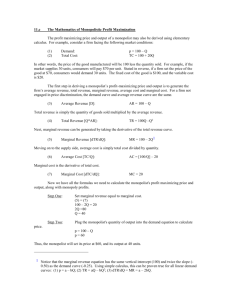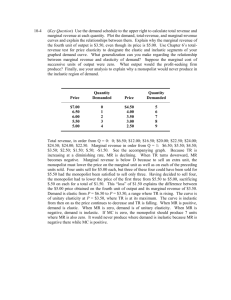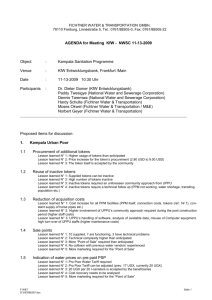Monopoly & Price Discrimination Practice Problems
advertisement
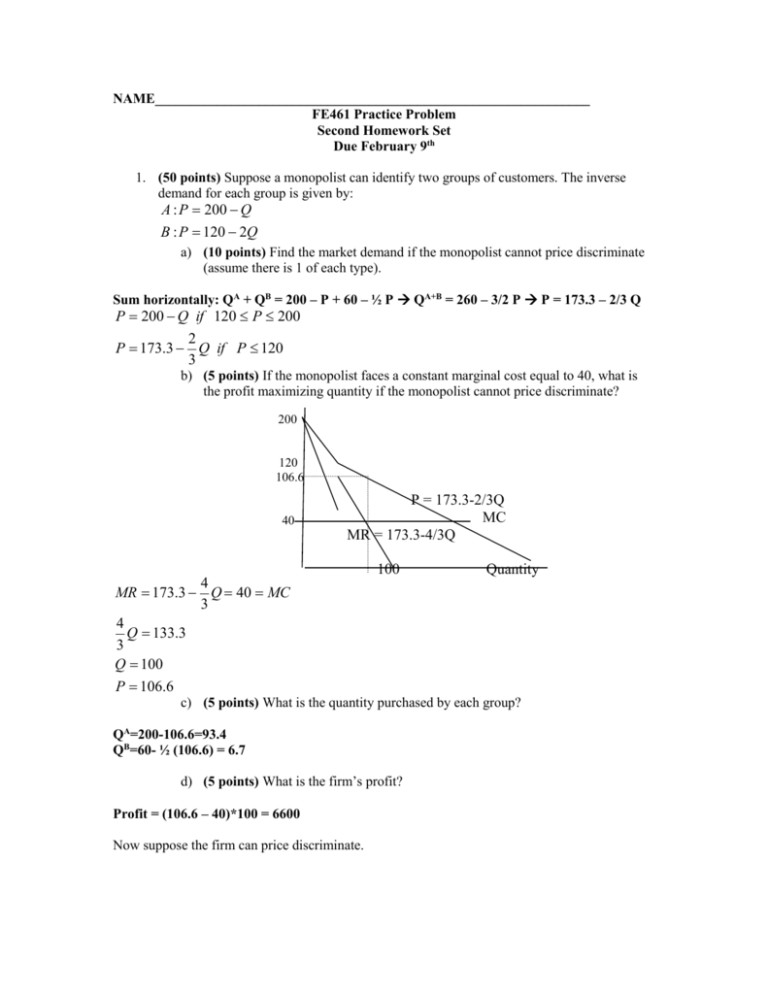
NAME_______________________________________________________________ FE461 Practice Problem Second Homework Set Due February 9th 1. (50 points) Suppose a monopolist can identify two groups of customers. The inverse demand for each group is given by: A : P 200 Q B : P 120 2Q a) (10 points) Find the market demand if the monopolist cannot price discriminate (assume there is 1 of each type). Sum horizontally: QA + QB = 200 – P + 60 – ½ P QA+B = 260 – 3/2 P P = 173.3 – 2/3 Q P 200 Q if 120 P 200 2 P 173.3 Q if P 120 3 b) (5 points) If the monopolist faces a constant marginal cost equal to 40, what is the profit maximizing quantity if the monopolist cannot price discriminate? 200 120 106.6 40 P = 173.3-2/3Q MC MR = 173.3-4/3Q 100 Quantity 4 MR 173.3 Q 40 MC 3 4 Q 133.3 3 Q 100 P 106.6 c) (5 points) What is the quantity purchased by each group? QA=200-106.6=93.4 QB=60- ½ (106.6) = 6.7 d) (5 points) What is the firm’s profit? Profit = (106.6 – 40)*100 = 6600 Now suppose the firm can price discriminate. e) (10 points) What price will the firm charge each group? P 200 P PA= 120 120 PB= 80 40=MC P=200-Q 80 MR=200-2Q 40=MC P=120-2Q 20 MR=120-4Q Quantity MRA=200-2Q = 40 = MC 160=2Q Q=80 PA=120 MRB=120-4Q = 40 = MC 80=4Q Q=20 PB=80 f) (5 points) What is the firm’s profit Profit = (PA-MC)QA+(PB-MC)QB Profit = (120 – 40)80 +(80 – 40)20 = 7200 g) (10 points) What happens to total surplus? (be sure to show specific numbers) 200 120 106.6 40 80 100 CS = ½ (200 – 120)80 + (120 – 106.6)80 + ½ (120-106.6)(100 – 80) = 4424 CSPD = ½ (200 – 120)80 + ½ (120 – 80)20 =3600 TSNO PD =4424 + 6600 = 11,024 TSPD = 3600 +7200 =10,800 NO PD 2. (25 points) Frank Buckely sells his famous bad tasting but very effective cough medicine in Toronto and Montreal. The inverse demand functions are given by: PT 18 QT PM 14 QM If the firm can price discriminate, what price will the firm charge each group if the marginal cost is given by: MC 1 2Q ? PT 18 QT MRT 18 2QT PM 14 QM MRM 14 2QM Invert MR and aggregate MR. 1 MRT 2 1 QM 7 MR M 2 Q 16 MR QT 9 Reinvert MR: Q 16 MR MR 16 Q Equate to MC MR 16 Q 1 2Q MC 15 3Q Q5 MR 16 5 11 Now need to go to each individual MR to find the Q and the price: MRT 18 2QT 11 QT 3.5 MRM 14 2QM 11 QM 1.5 Back to inverse demand functions for Prices: PT 18 QT PT 18 3.5 14.5 PM 14 QM PM 14 1.5 12.5 3. A nightclub owner has both student and adult customers. Assume the owner faces a constant marginal cost of $2 per drink. The demand for each group is given by: Q A 10 2 P QS 18 3P a) (10 points) If the owner cannot discriminate, what are the owner’s profits? If the club owner cannot price discriminate, she will consider the aggregate demand, which is Sum horizontally: QA + QS = 10 – 2P + 18 – 3P QA+S = 28 – 5P Inverting P 28 1 Q 5 5 The marginal revenue MR 28 2 Q 5 5 Equate marginal revenue with marginal cost, that is, 2 MR 28 2 Q 2 MC 5 5 Q9 Therefore, P 28 1 28 9 19 Q P 5 5 5 5 5 Her profit without price discrimination: 19 9 81 ( 2)9 ( )9 16.2 5 5 5 b) (10 points) If the owner could separate the groups and practice third-degree price discrimination what price per drink would be would be charged to each member? PA=5- ½ Q MRA=5-Q = 2 = MC 3=Q PA=3.5 PS=6- 1/3 Q MRS=6- 2/3 Q = 2 = MC 4(3/2)=Q Q=6 PS=4 c) (15 points) Suppose instead, the owner can “card” patrons to separate students from adults, and he can offer each group a cover charge and number of drink tokens. What will be the cover charge and number of tokens per student? Per adult? In this scenario, she can practice two-part pricing. For each group, the number of token will be equal to quantity demanded at price $2, which is the marginal cost of a drink. Number of tokens for students QS 18 3P 18 3(2) 12 , and the number of tokens for the adults QA 10 2P 10 2(2) 6 . Now, for each group, the cover charge should equal the consumer surplus received at the given number of tokens. 1 12(6 2) 24 cov er 2 With Drink tokens and cover total 24 2(12) 48 1 That is, Cover charge for a adult CS 6(5 2) 9 cov er 2 With Drink tokens and cover total 9 2(6) 21 That is, Cover charge for a student CS



